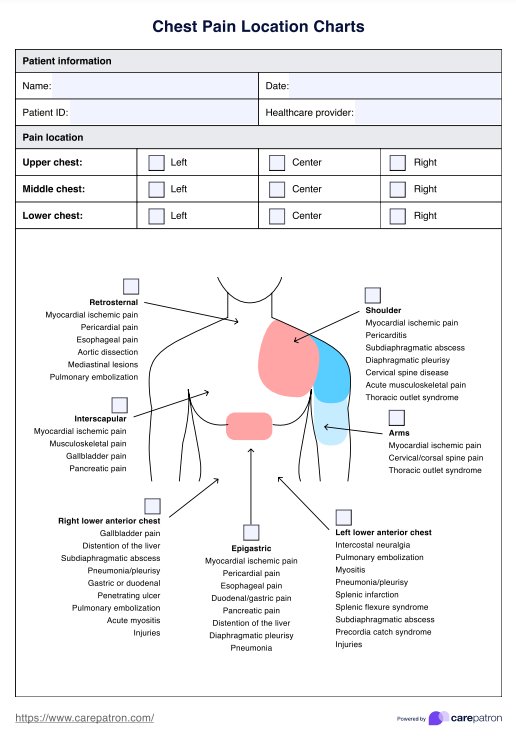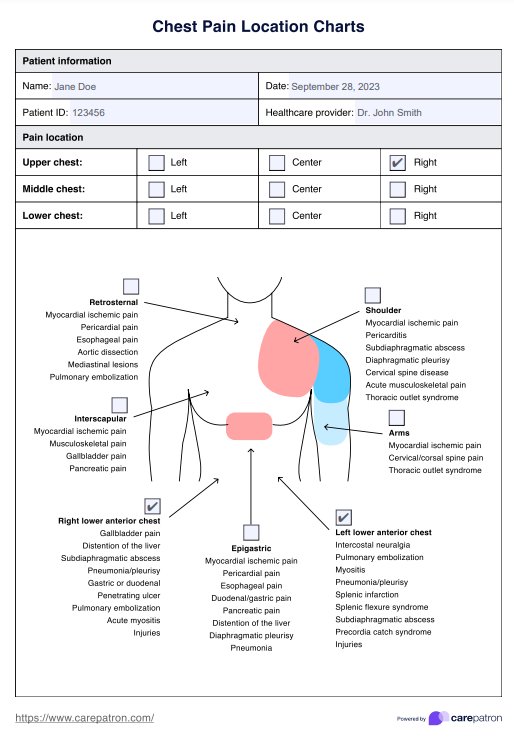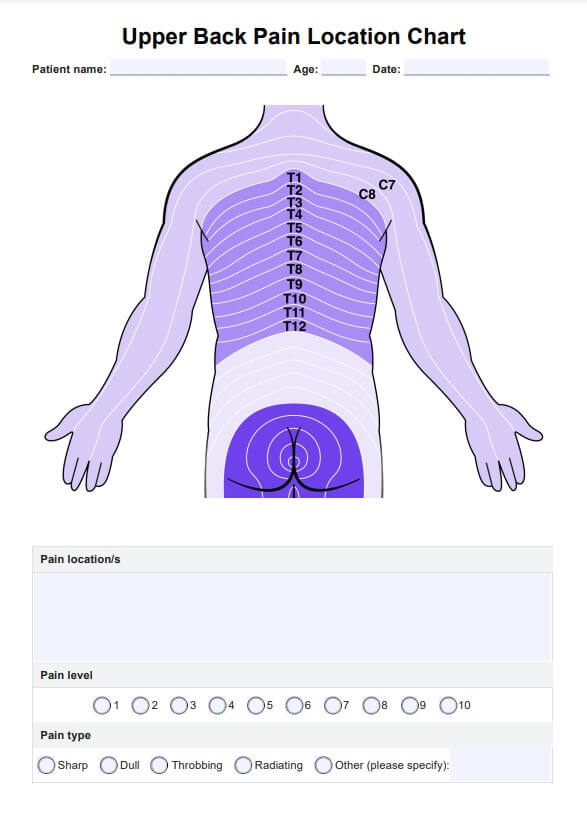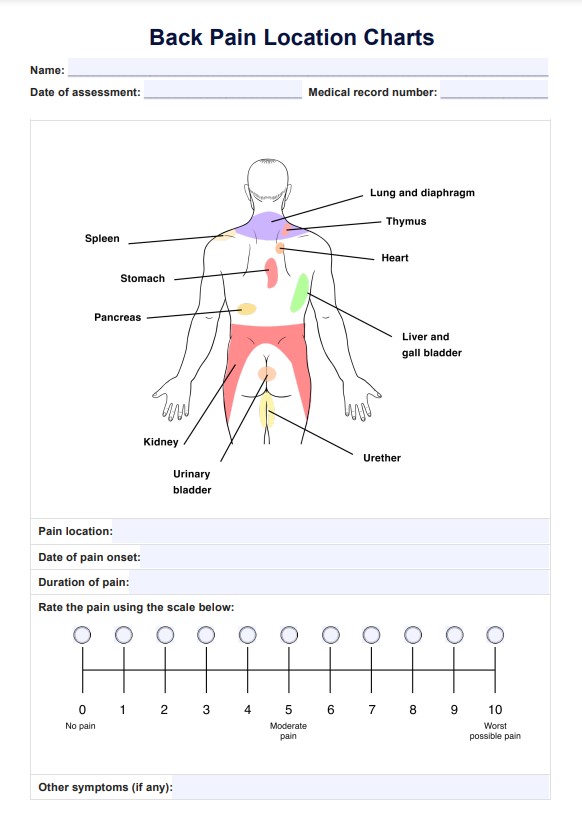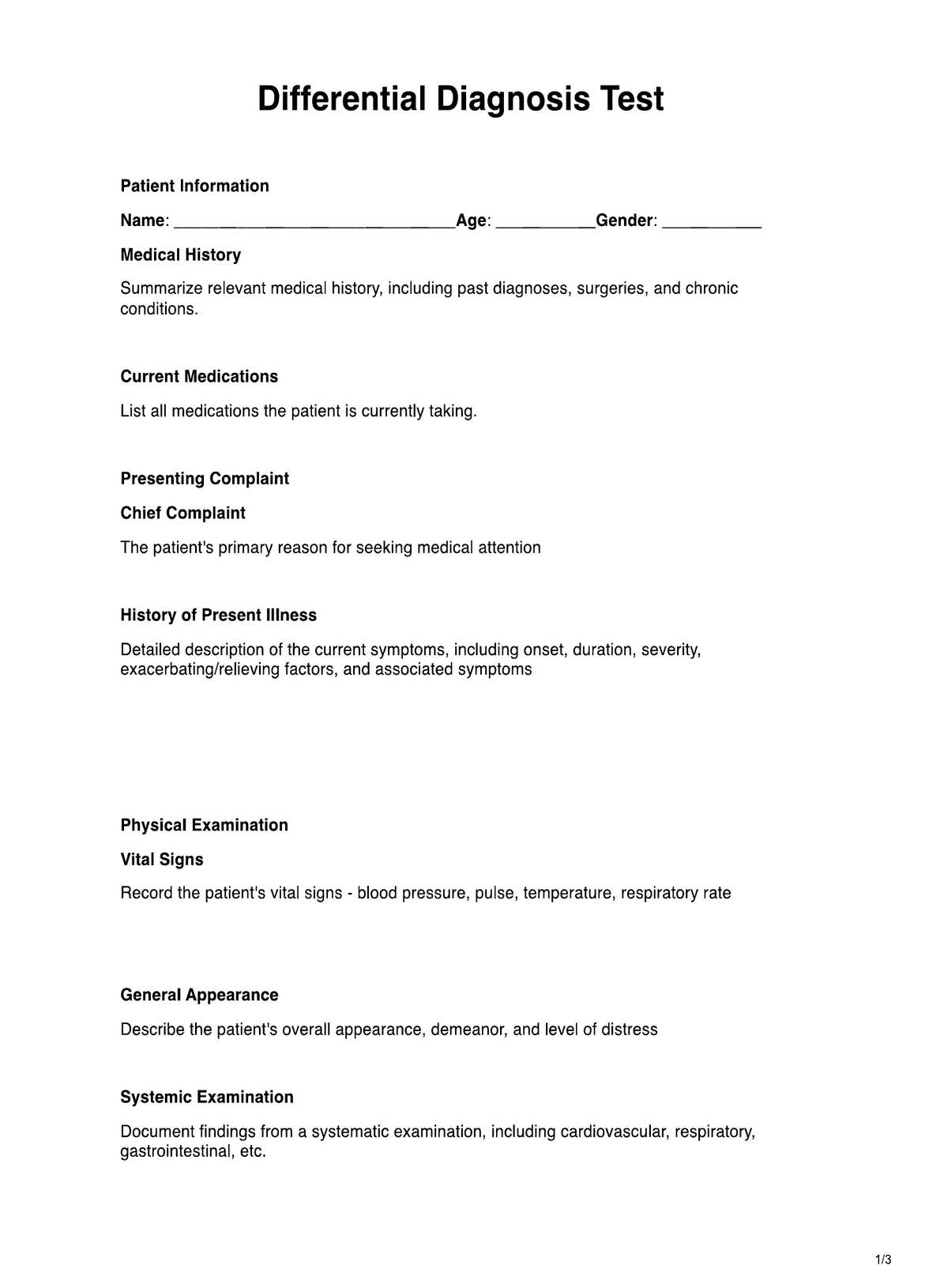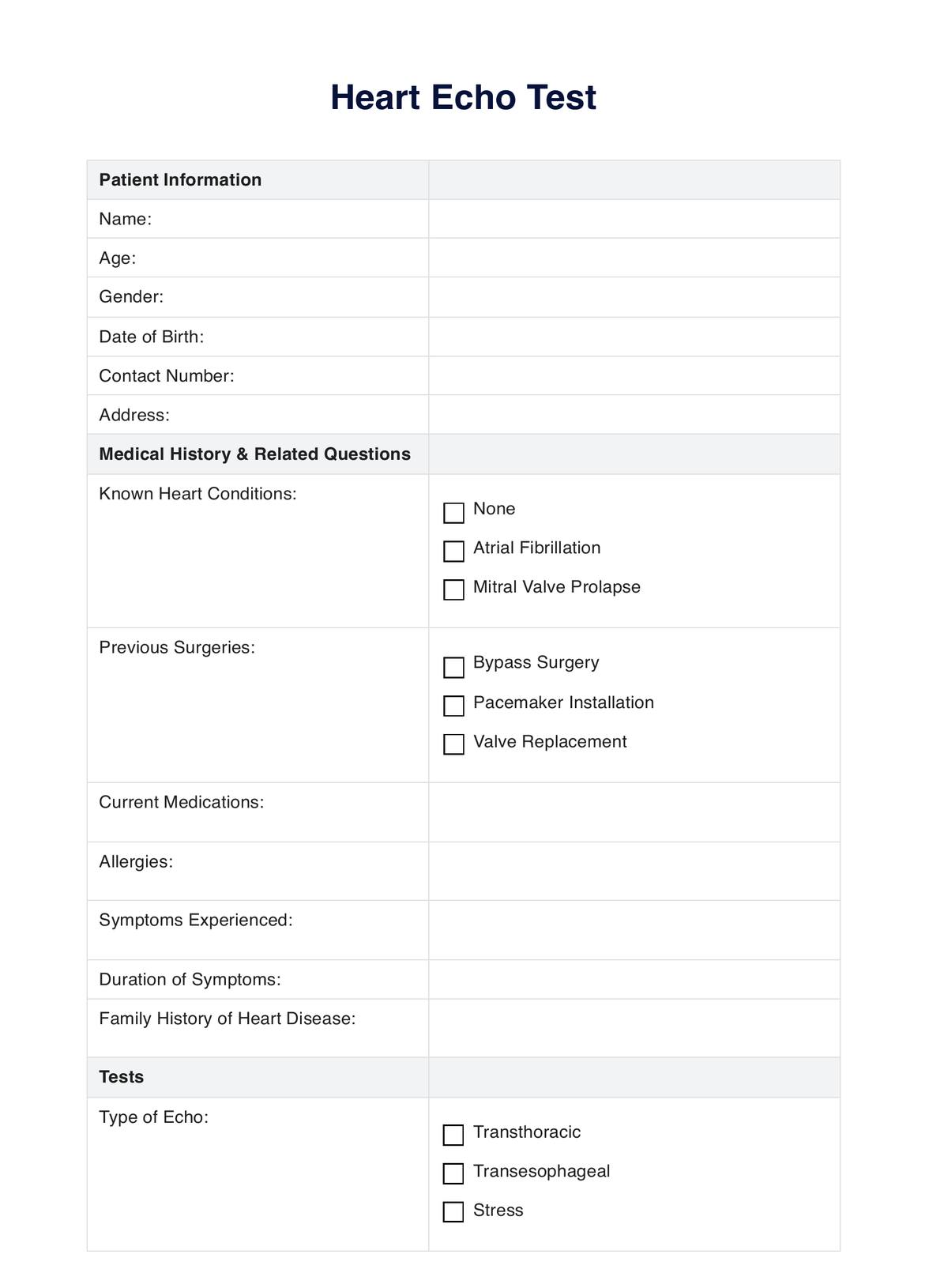Chest Pain Location Charts
Discover the benefits of using a Chest Pain Location Chart with Carepatron. Streamline diagnosis, enhance patient communication, and improve care outcomes.


What is a Chest Pain Location Chart?
A Chest Pain Location Chart is a crucial diagnostic tool in the healthcare industry, designed to accurately pinpoint the potential origin of chest discomfort. This chart features a human torso diagram, allowing patients to indicate the precise area of their pain. For instance, discomfort at the chest's center often suggests heart disease or related issues, such as angina or myocardial infarction. Conversely, pain experienced on the sides of the chest could indicate injuries like rib fractures of musculoskeletal issues like costochondritis.
The chart's layout is divided into distinct regions, each corresponding to various potential triggers of chest pain. By marking the exact location of the discomfort on the chart, healthcare professionals can gain valuable insights into the possible underlying medical conditions causing the distress. This initial identification can expedite the diagnostic process and guide further examination and treatment plans.
It's crucial to remember that while this chart is an invaluable aid in preliminary diagnosis, a comprehensive medical examination is always required to accurately confirm the cause of chest pain. To gain a more in-depth understanding of how Chest Pain Location Charts work and their role in clinical settings, watch our explainer video.
Chest Pain Location Charts Template
Chest Pain Location Charts Example
How to use the Chest Pain Location Chart
The Chest Pain Location Chart is a valuable diagnostic tool in healthcare. Here's a step-by-step guide on how to utilize this chart effectively:
Step 1: Access the template
First off, access the template on the Carepatron app by clicking "Use Template." You can customize the template on the app before printing or sharing. You can also download a non-customizable PDF version by clicking "Download."
Step 2: Decipher the nature of the pain
Initiate the process by asking the patient to characterize their pain. It could be sharp, dull, stabbing, burning, or squeezing. You can also ask them to provide a more accurate description if none of the terms don't fit perfectly. Understanding the nature of the pain can offer significant insights into its potential cause.
Step 3: Pinpoint the pain
Next, request the patient to indicate the exact location of their discomfort on the Chest Pain Location Chart. This may be easier if you have a printed copy or a mobile device that you can hand to the patient. If the pain extends or radiates to other regions, it's essential to mark these areas too. The precise location can provide clues about what's triggering the pain.
Step 4: Note additional symptoms
It's crucial to record any other symptoms that the patient might be experiencing alongside chest pain. These could range from shortness of breath and nausea to dizziness or fatigue. Determining the presence of these symptoms is vital in case the patient is experiencing life-threatening conditions that first manifest as acute chest pain.
Step 5: Do additional tests
Once you and your patient have pinpointed the pain location, start doing other clinical tests to ascertain the true cause and nature of the pain. These may include physical examination, blood tests, or imaging such as chest x-ray, electrocardiogram (EKG/ECG), or an echocardiogram. These tests will let you see into the heart, lungs, blood vessels, and surrounding skeletal structures.
Step 6: Analyze the collected information
Use the data gathered from the Chest Pain Location Chart and the other tests to help identify potential causes of chest pain. The specific location and type of pain and other reported symptoms can offer valuable insights that guide the diagnostic process.
When would you use this chart?
The Chest Pain Location Chart is a versatile tool with applications in various healthcare settings. Its primary purpose is to streamline the initial diagnosis process when a patient presents with severe chest pain, offering valuable insights into potential causes based on the pain's location.
One of the most critical applications of this chart is in emergency medical situations. When a patient arrives in an emergency department with chest pain, time is of the essence. The Chest Pain Location Chart allows healthcare professionals to quickly assess the pain's location and potentially identify its cause. This rapid preliminary diagnosis can expedite treatment, which can be crucial, especially if they have a life-threatening condition like a pulmonary embolism (a blood clot in the lungs), a myocardial infarction (a heart attack), or aortic dissection (torn inner walls of the aorta), or coronary artery disease.
But the uses of the Chest Pain Location Chart aren't confined to emergency settings. It can also be a helpful tool during routine check-ups or outpatient visits. If a patient reports experiencing occasional or chronic chest pain, the chart can help track the pain's location over time. This data can then be used to identify patterns, monitor the effectiveness of treatments, and make informed decisions about further diagnostic tests or changes in therapy. It will also help form management or treatment plans for injuries, making sure you do not make the pain worse.
Moreover, the chart can be used in specialized clinics such as cardiology or gastroenterology. Here, it can help differentiate between cardiac and non-cardiac causes of sharp chest pain, guiding more specific investigations.
Benefits of Using Chest Pain Location Charts
The Chest Pain Location Chart is a valuable tool in medical practice, offering multiple benefits. Here are some key advantages:
Streamlining diagnosis
The chart simplifies the diagnostic process by visually representing the patient's pain, which can guide healthcare professionals toward potential causes.
Serving as a quick reference
As a quick reference tool, the Chest Pain Location Chart aids decision-making, enabling healthcare professionals to make informed preliminary diagnoses more efficiently.
Facilitating personalized care
By considering each patient's unique symptoms and their exact location, the chart enables healthcare providers to deliver personalized care tailored to individual needs.
Enhancing patient-provider communication
The chart serves as a communication bridge between the patient and the healthcare provider. It ensures that the patient's pain is accurately described, understood, and recorded, leading to more effective treatment plans.
Aiding in condition monitoring
Over time, the chart can help monitor the progress or changes in a patient's condition, providing valuable data that can inform adjustments to treatment strategies.
Serving as an educational tool
The chart can educate patients about the potential causes of their chest pain, empowering them with knowledge and facilitating their active participation in their healthcare journey. It even includes surrounding areas (like the right and left arm) and symptoms that appear unrelated (such as jaw pain) which may actually help in diagnosing conditions.
However, it's important to note that while the Chest Pain Location Chart is a useful diagnostic aid, it does not replace further medical evaluation. Confirming a diagnosis necessitates additional diagnostic tests such as EKGs and blood tests, which will help differentiate between chest wall pain and cardiovascular or pulmonary conditions. Thus, the chart should be considered part of an integrated diagnostic approach rather than a standalone tool.
Commonly asked questions
Chest Pain Location Chart are typically used by healthcare professionals, including doctors, nurses, and paramedics, to help diagnose the cause of a patient's unexplained chest pain.
These charts are used when a patient presents with chest pain. They can be particularly useful in emergency settings, where quick diagnosis is essential, but can also be used in routine check-ups.
The patient marks the exact location of their pain on the chart. This information, combined with other symptoms, helps healthcare professionals identify potential causes of the pain.
A Chest Pain Location Chart can facilitate communication between the patient and healthcare provider, ensuring the pain is accurately described and understood. It can also help by providing a visual representation of the patient's pain, aiding in diagnosis.

.jpg)
